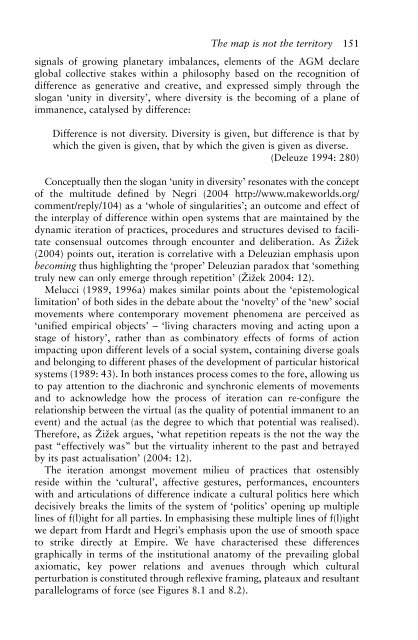Complexity and Social Movements: Multitudes at the Edge of Chaos ...
Complexity and Social Movements: Multitudes at the Edge of Chaos ...
Complexity and Social Movements: Multitudes at the Edge of Chaos ...
Create successful ePaper yourself
Turn your PDF publications into a flip-book with our unique Google optimized e-Paper software.
The map is not <strong>the</strong> territory 151<br />
signals <strong>of</strong> growing planetary imbalances, elements <strong>of</strong> <strong>the</strong> AGM declare<br />
global collective stakes within a philosophy based on <strong>the</strong> recognition <strong>of</strong><br />
difference as gener<strong>at</strong>ive <strong>and</strong> cre<strong>at</strong>ive, <strong>and</strong> expressed simply through <strong>the</strong><br />
slogan ‘unity in diversity’, where diversity is <strong>the</strong> becoming <strong>of</strong> a plane <strong>of</strong><br />
immanence, c<strong>at</strong>alysed by difference:<br />
Difference is not diversity. Diversity is given, but difference is th<strong>at</strong> by<br />
which <strong>the</strong> given is given, th<strong>at</strong> by which <strong>the</strong> given is given as diverse.<br />
(Deleuze 1994: 280)<br />
Conceptually <strong>the</strong>n <strong>the</strong> slogan ‘unity in diversity’ reson<strong>at</strong>es with <strong>the</strong> concept<br />
<strong>of</strong> <strong>the</strong> multitude defined by Negri (2004 http://www.makeworlds.org/<br />
comment/reply/104) as a ‘whole <strong>of</strong> singularities’; an outcome <strong>and</strong> effect <strong>of</strong><br />
<strong>the</strong> interplay <strong>of</strong> difference within open systems th<strong>at</strong> are maintained by <strong>the</strong><br />
dynamic iter<strong>at</strong>ion <strong>of</strong> practices, procedures <strong>and</strong> structures devised to facilit<strong>at</strong>e<br />
consensual outcomes through encounter <strong>and</strong> deliber<strong>at</strong>ion. As Didek<br />
(2004) points out, iter<strong>at</strong>ion is correl<strong>at</strong>ive with a Deleuzian emphasis upon<br />
becoming thus highlighting <strong>the</strong> ‘proper’ Deleuzian paradox th<strong>at</strong> ‘something<br />
truly new can only emerge through repetition’ (Didek 2004: 12).<br />
Melucci (1989, 1996a) makes similar points about <strong>the</strong> ‘epistemological<br />
limit<strong>at</strong>ion’ <strong>of</strong> both sides in <strong>the</strong> deb<strong>at</strong>e about <strong>the</strong> ‘novelty’ <strong>of</strong> <strong>the</strong> ‘new’ social<br />
movements where contemporary movement phenomena are perceived as<br />
‘unified empirical objects’ – ‘living characters moving <strong>and</strong> acting upon a<br />
stage <strong>of</strong> history’, r<strong>at</strong>her than as combin<strong>at</strong>ory effects <strong>of</strong> forms <strong>of</strong> action<br />
impacting upon different levels <strong>of</strong> a social system, containing diverse goals<br />
<strong>and</strong> belonging to different phases <strong>of</strong> <strong>the</strong> development <strong>of</strong> particular historical<br />
systems (1989: 43). In both instances process comes to <strong>the</strong> fore, allowing us<br />
to pay <strong>at</strong>tention to <strong>the</strong> diachronic <strong>and</strong> synchronic elements <strong>of</strong> movements<br />
<strong>and</strong> to acknowledge how <strong>the</strong> process <strong>of</strong> iter<strong>at</strong>ion can re-configure <strong>the</strong><br />
rel<strong>at</strong>ionship between <strong>the</strong> virtual (as <strong>the</strong> quality <strong>of</strong> potential immanent to an<br />
event) <strong>and</strong> <strong>the</strong> actual (as <strong>the</strong> degree to which th<strong>at</strong> potential was realised).<br />
Therefore, as Didek argues, ‘wh<strong>at</strong> repetition repe<strong>at</strong>s is <strong>the</strong> not <strong>the</strong> way <strong>the</strong><br />
past “effectively was” but <strong>the</strong> virtuality inherent to <strong>the</strong> past <strong>and</strong> betrayed<br />
by its past actualis<strong>at</strong>ion’ (2004: 12).<br />
The iter<strong>at</strong>ion amongst movement milieu <strong>of</strong> practices th<strong>at</strong> ostensibly<br />
reside within <strong>the</strong> ‘cultural’, affective gestures, performances, encounters<br />
with <strong>and</strong> articul<strong>at</strong>ions <strong>of</strong> difference indic<strong>at</strong>e a cultural politics here which<br />
decisively breaks <strong>the</strong> limits <strong>of</strong> <strong>the</strong> system <strong>of</strong> ‘politics’ opening up multiple<br />
lines <strong>of</strong> f(l)ight for all parties. In emphasising <strong>the</strong>se multiple lines <strong>of</strong> f(l)ight<br />
we depart from Hardt <strong>and</strong> Hegri’s emphasis upon <strong>the</strong> use <strong>of</strong> smooth space<br />
to strike directly <strong>at</strong> Empire. We have characterised <strong>the</strong>se differences<br />
graphically in terms <strong>of</strong> <strong>the</strong> institutional an<strong>at</strong>omy <strong>of</strong> <strong>the</strong> prevailing global<br />
axiom<strong>at</strong>ic, key power rel<strong>at</strong>ions <strong>and</strong> avenues through which cultural<br />
perturb<strong>at</strong>ion is constituted through reflexive framing, pl<strong>at</strong>eaux <strong>and</strong> resultant<br />
parallelograms <strong>of</strong> force (see Figures 8.1 <strong>and</strong> 8.2).




